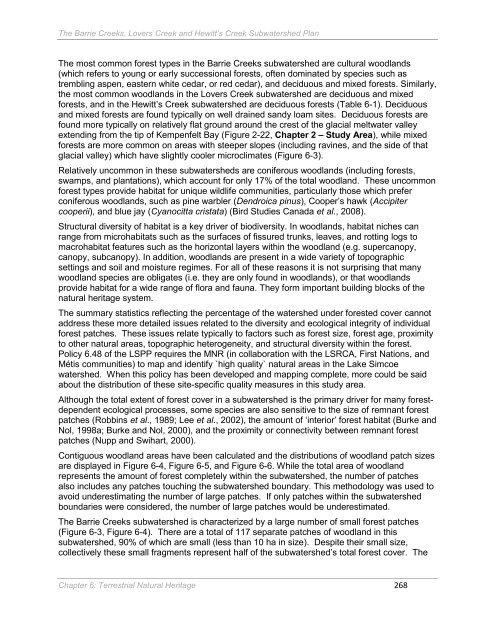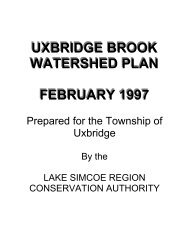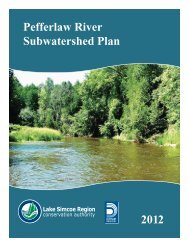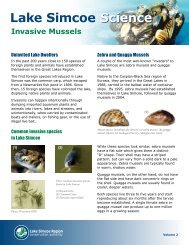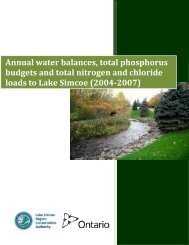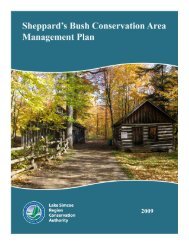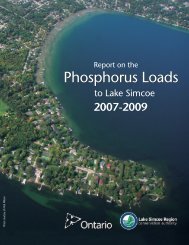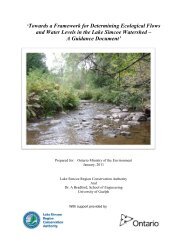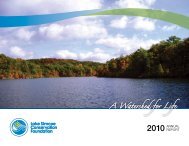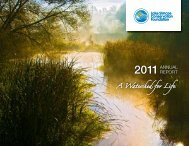Barrie Creeks, Lovers Creek, and Hewitt's Creek Subwatershed Plan
Barrie Creeks, Lovers Creek, and Hewitt's Creek Subwatershed Plan
Barrie Creeks, Lovers Creek, and Hewitt's Creek Subwatershed Plan
You also want an ePaper? Increase the reach of your titles
YUMPU automatically turns print PDFs into web optimized ePapers that Google loves.
The <strong>Barrie</strong> <strong><strong>Creek</strong>s</strong>, <strong>Lovers</strong> <strong>Creek</strong> <strong>and</strong> Hewitt’s <strong>Creek</strong> <strong>Subwatershed</strong> <strong>Plan</strong><br />
The most common forest types in the <strong>Barrie</strong> <strong><strong>Creek</strong>s</strong> subwatershed are cultural woodl<strong>and</strong>s<br />
(which refers to young or early successional forests, often dominated by species such as<br />
trembling aspen, eastern white cedar, or red cedar), <strong>and</strong> deciduous <strong>and</strong> mixed forests. Similarly,<br />
the most common woodl<strong>and</strong>s in the <strong>Lovers</strong> <strong>Creek</strong> subwatershed are deciduous <strong>and</strong> mixed<br />
forests, <strong>and</strong> in the Hewitt’s <strong>Creek</strong> subwatershed are deciduous forests (Table 6-1). Deciduous<br />
<strong>and</strong> mixed forests are found typically on well drained s<strong>and</strong>y loam sites. Deciduous forests are<br />
found more typically on relatively flat ground around the crest of the glacial meltwater valley<br />
extending from the tip of Kempenfelt Bay (Figure 2-22, Chapter 2 – Study Area), while mixed<br />
forests are more common on areas with steeper slopes (including ravines, <strong>and</strong> the side of that<br />
glacial valley) which have slightly cooler microclimates (Figure 6-3).<br />
Relatively uncommon in these subwatersheds are coniferous woodl<strong>and</strong>s (including forests,<br />
swamps, <strong>and</strong> plantations), which account for only 17% of the total woodl<strong>and</strong>. These uncommon<br />
forest types provide habitat for unique wildlife communities, particularly those which prefer<br />
coniferous woodl<strong>and</strong>s, such as pine warbler (Dendroica pinus), Cooper’s hawk (Accipiter<br />
cooperii), <strong>and</strong> blue jay (Cyanocitta cristata) (Bird Studies Canada et al., 2008).<br />
Structural diversity of habitat is a key driver of biodiversity. In woodl<strong>and</strong>s, habitat niches can<br />
range from microhabitats such as the surfaces of fissured trunks, leaves, <strong>and</strong> rotting logs to<br />
macrohabitat features such as the horizontal layers within the woodl<strong>and</strong> (e.g. supercanopy,<br />
canopy, subcanopy). In addition, woodl<strong>and</strong>s are present in a wide variety of topographic<br />
settings <strong>and</strong> soil <strong>and</strong> moisture regimes. For all of these reasons it is not surprising that many<br />
woodl<strong>and</strong> species are obligates (i.e. they are only found in woodl<strong>and</strong>s), or that woodl<strong>and</strong>s<br />
provide habitat for a wide range of flora <strong>and</strong> fauna. They form important building blocks of the<br />
natural heritage system.<br />
The summary statistics reflecting the percentage of the watershed under forested cover cannot<br />
address these more detailed issues related to the diversity <strong>and</strong> ecological integrity of individual<br />
forest patches. These issues relate typically to factors such as forest size, forest age, proximity<br />
to other natural areas, topographic heterogeneity, <strong>and</strong> structural diversity within the forest.<br />
Policy 6.48 of the LSPP requires the MNR (in collaboration with the LSRCA, First Nations, <strong>and</strong><br />
Métis communities) to map <strong>and</strong> identify `high quality` natural areas in the Lake Simcoe<br />
watershed. When this policy has been developed <strong>and</strong> mapping complete, more could be said<br />
about the distribution of these site-specific quality measures in this study area.<br />
Although the total extent of forest cover in a subwatershed is the primary driver for many forestdependent<br />
ecological processes, some species are also sensitive to the size of remnant forest<br />
patches (Robbins et al., 1989; Lee et al., 2002), the amount of ‘interior’ forest habitat (Burke <strong>and</strong><br />
Nol, 1998a; Burke <strong>and</strong> Nol, 2000), <strong>and</strong> the proximity or connectivity between remnant forest<br />
patches (Nupp <strong>and</strong> Swihart, 2000).<br />
Contiguous woodl<strong>and</strong> areas have been calculated <strong>and</strong> the distributions of woodl<strong>and</strong> patch sizes<br />
are displayed in Figure 6-4, Figure 6-5, <strong>and</strong> Figure 6-6. While the total area of woodl<strong>and</strong><br />
represents the amount of forest completely within the subwatershed, the number of patches<br />
also includes any patches touching the subwatershed boundary. This methodology was used to<br />
avoid underestimating the number of large patches. If only patches within the subwatershed<br />
boundaries were considered, the number of large patches would be underestimated.<br />
The <strong>Barrie</strong> <strong><strong>Creek</strong>s</strong> subwatershed is characterized by a large number of small forest patches<br />
(Figure 6-3, Figure 6-4). There are a total of 117 separate patches of woodl<strong>and</strong> in this<br />
subwatershed, 90% of which are small (less than 10 ha in size). Despite their small size,<br />
collectively these small fragments represent half of the subwatershed’s total forest cover. The<br />
Chapter 6: Terrestrial Natural Heritage 268


